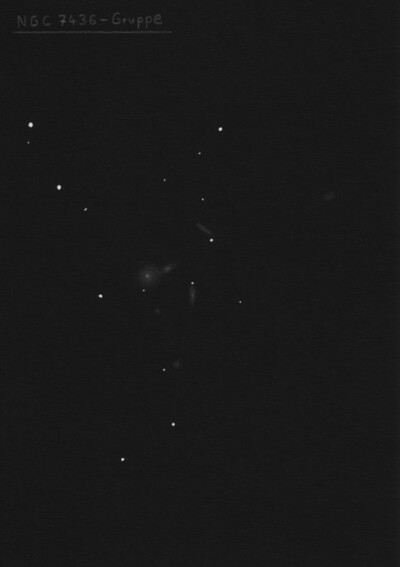
William Herschel discovered NGC 7436 = H III-243 = h2195 on 2 Dec 1784 (only object in sweep 327) and recorded "vF, S, er, but I have not been out long enough to see very well, and it may be only stars." On 18 Aug 1828 (sweep 167), JH logged "F; E in parallel; gbM; 60" l, 30" br." Although not resolved, the elongation was caused by the superimposed companion on the west side.
The RNGC identifies the brighter eastern component as NGC 7436A and the western component as NGC 7436B. The identification problems with this group (specifically NGC 7433 and 7431) are discussed in detail in the Oct 1989 Webb Society Quarterly Journal and in Malcolm Thomson's unpublished "Catalogue Corrections".
R.J. Mitchell discovered NGC 7436B = MCG +04-54-005 = PGC 70123 on 23 Oct 1855 and noted "3 neb; last one [NGC 7436] pB, bM, has either a star or nebulous knot closely p [NGC 7436]; ...." The "nebulous knot" is NGC 7436B. He observed the group again on 18 Sep 1857 and logged, "... closely p is a * or sharply defined nebulous patch, ..." Dreyer observed the group on 29 Sep 1875 and reported, "The object p in the diagram from 1857 is a F *. Night bad." Harold Corwin notes that based on Dreyer's own observation, he didn't assign the western component of NGC 7436 an NGC designation. NED identifies this galaxy as NGC 7436A and HyperLEDA calls it NGC 7436B.
400/500mm - 17.5" (8/25/95): brightest in a tight group of four galaxies including NGC 7431, NGC 7433 and NGC 7435. Fairly faint, small, round, 1.2' diameter. Well concentrated with a small, bright core. The view is confused by a companion, which is partially superimposed on the west side of the halo and creates the impression of elongation E-W. A mag 15 star is 50" SW and a mag 14.5 star 1.3' WNW.
17.5" (9/2/89): brightest in a group, faint, small, slightly elongated N-S, bright core. Forms a double system with NGC 7433 attached at the west end. In a group with NGC 7435 1.0' SW, NGC 7431 2' NW (not seen). Located 15' E of mag 8.9 SAO 90886.
600/800mm - 24" (7/20/12): brightest and central galaxy in a group with three extremely close companions. At 325x appeared moderately bright and large, round, ~1' diameter. Sharply concentrated and dominated by a very bright small core. The halo has a low surface brightness and gradually fades out, but seems to encompass NGC 7436B = VV 84b, which appeared as a faint or fairly faint thin spike, ~22"x8", emerging from the halo and extending west. NGC 7435 is just 57" SW and NGC 7433 is 1.5' NW. Also nearby are MCG +04-54-007 2.4' S, PGC 1766408 3.4' NW, NGC 7431 4.2' WNW and PGC 1768375 is 5.7' NNW.
MCG +04-54-007 is extremely faint or very faint, very small, round, 12" diameter. A mag 16.1 star lies 20" E. PGC 1766408 is extremely faint, very small, irregularly round, 15"x12". PGC 1768375 is extremely faint and small, round, 9" diameter. Collinear with a mag 15 star 0.7' NE and a mag 13 star 1.2' NE.
900/1200mm - 48" (10/26/16): brightest of a total of 8 galaxies observed within 4'. At 610x; bright, moderately large, round, sharply concentrated with a very bright small core, increasing to a stellar nucleus. The halo has a much lower surface brightness and contains NGC 7436B, which pokes out of the halo on the west side. The contact companion appeared moderately bright, fairly small, very elongated 3:1 E-W, 24"x8", very small bright nucleus.
Notes by Steve Gottlieb